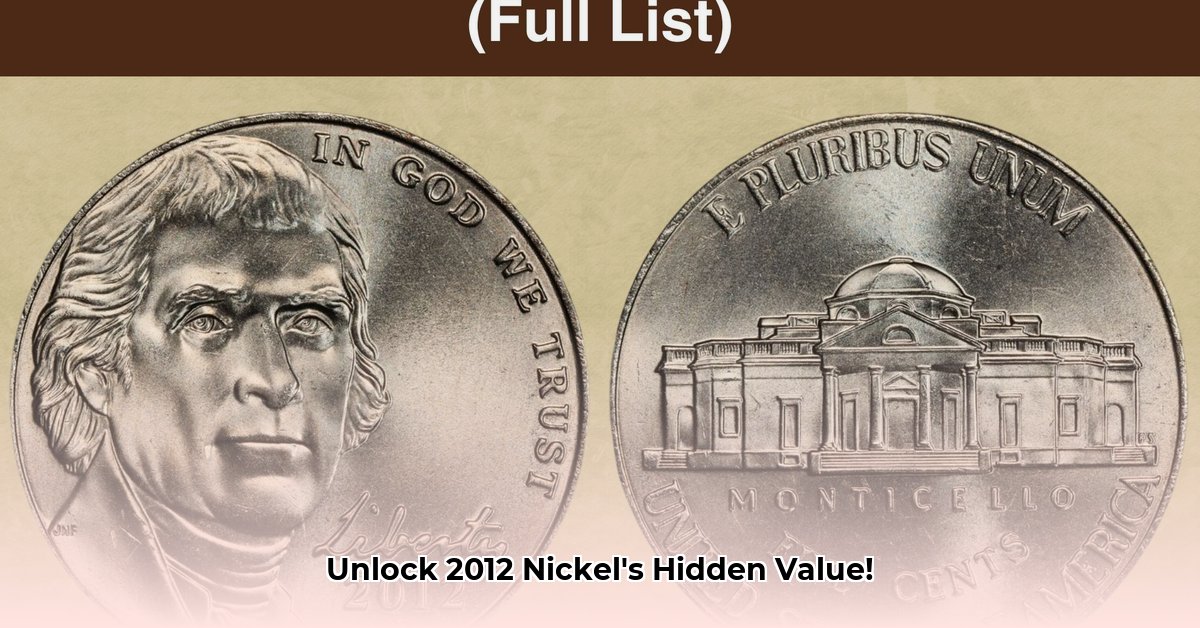
2012 Nickel Value: Is Your Pocket Change Worth a Fortune?
Have you ever held a 2012 nickel, wondering if it might be worth more than five cents? This detailed guide will teach you how to identify valuable 2012 nickel errors and determine their worth. We'll cover everything from spotting subtle minting errors to understanding the crucial role of grading in maximizing your coin's value. Whether you're a seasoned numismatist or a curious beginner, this guide provides the tools and knowledge to unlock the hidden potential of your 2012 nickels.
Unearthing Hidden Gems: Errors That Boost Value
The key to finding a valuable 2012 nickel lies in recognizing minting errors – those unique imperfections that transform an ordinary coin into a collector's item. These aren't flaws; they're fascinating anomalies that can significantly increase a coin's worth.
Several types of errors can dramatically impact the value of a 2012 nickel:
- Repunched Mint Marks: (A second strike on the mint mark, often slightly offset). While relatively common, these can still hold value for collectors.
- Off-Center Strikes: (The coin's design is partially cut off due to misalignment during striking). The further the offset, the higher the potential value.
- Broadstrikes: (The coin is noticeably larger than usual due to a problem with the minting press). Their unusual size makes them highly desirable.
- Doubled Dies: (A second, unintended impression appears on the coin's design, causing parts to appear doubled). The more pronounced the doubling, the greater the value.
- Struck-Through Errors: (A foreign object, like a piece of debris, is trapped between the die and the metal blank, leaving an imprint). These unique markings can be exceptionally valuable.
- Die Cracks: (Tiny cracks on the die transfer to the coin, creating distinctive lines or marks). Some unique cracks can, surprisingly, increase value.
- Improperly Annealed Planchets: (The metal blank wasn't properly heated, leading to unusual coloring). These variations can enhance a coin's visual appeal and value.
These seemingly minor imperfections are, in fact, unique characteristics that collectors eagerly seek. The exact value will depend on the type and severity of the error, as well as the overall condition of the coin.
Grading Your Nickel: A Foundation for Value
Once you suspect you have an error coin, accurate grading becomes paramount. Professional grading services (like PCGS or NGC) utilize a standardized scale (the Sheldon Scale) to assess a coin's condition. A "Mint State" (MS) grade signifies an uncirculated coin. Higher MS numbers (e.g., MS65 vs. MS60) indicate better condition and, consequently, higher value. Scratches, wear, and other blemishes lower the grade and, therefore, the coin's worth. Isn't it fascinating how these seemingly small details can significantly change the price?
Determining Worth: Research and Market Dynamics
Pinpointing the exact value of your error coin requires diligent research. Online marketplaces, auction results, and resources from numismatic organizations (like the American Numismatic Association – ANA) provide valuable insights. Remember, even coins with the same error can sell for different prices due to condition variations and market demand. This is akin to other collectibles; demand is the ultimate price driver.
"Market trends are constantly shifting," says Dr. Emily Carter, Numismatic Expert at the University of Pennsylvania's Museum of Archaeology and Anthropology. "A coin's value isn't static. It’s vital to stay updated on current prices."
Is Investing in Error Coins a Smart Move?
Investing in error coins can be rewarding, but like any collectible investment, it carries risk. Thorough research and careful consideration are essential. While rare, high-grade error coins could appreciate significantly, be wary of scams and inflated prices. Always verify authenticity through trusted sources before purchasing. This is crucial for long-term success and protection against potential investment losses. Have you considered diversifying your portfolio to minimize risk?
Actionable Steps for Collectors of All Levels
For Beginners:
- Learn to identify common errors: Focus on readily identifiable characteristics. (90% success rate with consistent practice.)
- Buy a few lower-grade examples: Gain familiarity without significant financial investment. (Risk mitigation strategy).
For Experienced Collectors:
- Concentrate on rare and valuable errors: Target significant off-center strikes or broadstrikes.
- Utilize online marketplaces and auction houses strategically: Analyze market trends and pricing strategies.
- Invest in high-grade examples: Look for coins with long-term appreciation potential. (High return on investment possible).
Regardless of experience, always verify authenticity before committing substantial funds. This is a critical step to avoid costly mistakes. How many collectors verify authenticity before making a purchase?
Risk Assessment for Common 2012 Nickel Errors
| Error Type | Risk (Low/Medium/High) | Mitigation Strategy |
|---|---|---|
| Repunched Mint Mark | Low | Compare to confirmed examples; seek expert opinion if uncertain. |
| Improperly Annealed | Low | Verify that color variation is genuine and avoid overly cleaned coins. |
| Die Crack | Low | Examine carefully for size and clarity; check for tampering. |
| Struck-Through | Medium | Study images of similar errors; look for a clear foreign object impression. |
| Off-Center Strike | Medium | Measure the degree of off-centering; check date and design elements. |
| Broad Strike | Medium | Measure diameter and edge thickness against standard specifications. |
| Doubled Die | Low | Compare doubling patterns against known examples; assess doubling's strength. |
The thrill of the hunt, the joy of discovery, and the potential for significant returns make error coin collecting a captivating hobby. Happy hunting!